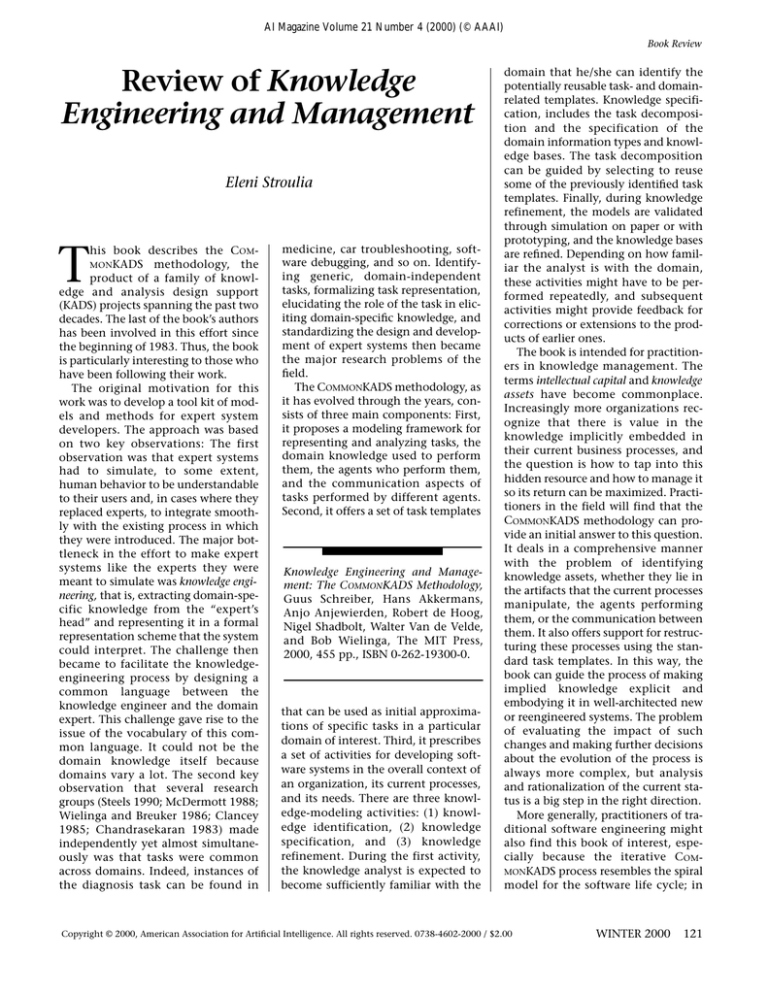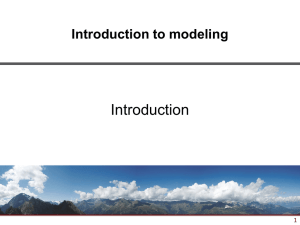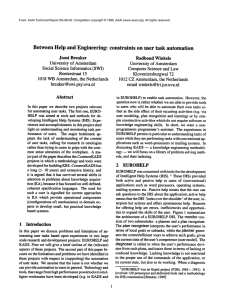
AI Magazine Volume 21 Number 4 (2000) (© AAAI)
Book Review
Review of Knowledge
Engineering and Management
Eleni Stroulia
T
his book describes the COMMON KADS methodology, the
product of a family of knowledge and analysis design support
(KADS) projects spanning the past two
decades. The last of the book’s authors
has been involved in this effort since
the beginning of 1983. Thus, the book
is particularly interesting to those who
have been following their work.
The original motivation for this
work was to develop a tool kit of models and methods for expert system
developers. The approach was based
on two key observations: The first
observation was that expert systems
had to simulate, to some extent,
human behavior to be understandable
to their users and, in cases where they
replaced experts, to integrate smoothly with the existing process in which
they were introduced. The major bottleneck in the effort to make expert
systems like the experts they were
meant to simulate was knowledge engineering, that is, extracting domain-specific knowledge from the “expert’s
head” and representing it in a formal
representation scheme that the system
could interpret. The challenge then
became to facilitate the knowledgeengineering process by designing a
common language between the
knowledge engineer and the domain
expert. This challenge gave rise to the
issue of the vocabulary of this common language. It could not be the
domain knowledge itself because
domains vary a lot. The second key
observation that several research
groups (Steels 1990; McDermott 1988;
Wielinga and Breuker 1986; Clancey
1985; Chandrasekaran 1983) made
independently yet almost simultaneously was that tasks were common
across domains. Indeed, instances of
the diagnosis task can be found in
medicine, car troubleshooting, software debugging, and so on. Identifying generic, domain-independent
tasks, formalizing task representation,
elucidating the role of the task in eliciting domain-specific knowledge, and
standardizing the design and development of expert systems then became
the major research problems of the
field.
The COMMONKADS methodology, as
it has evolved through the years, consists of three main components: First,
it proposes a modeling framework for
representing and analyzing tasks, the
domain knowledge used to perform
them, the agents who perform them,
and the communication aspects of
tasks performed by different agents.
Second, it offers a set of task templates
Knowledge Engineering and Management: The COMMONKADS Methodology,
Guus Schreiber, Hans Akkermans,
Anjo Anjewierden, Robert de Hoog,
Nigel Shadbolt, Walter Van de Velde,
and Bob Wielinga, The MIT Press,
2000, 455 pp., ISBN 0-262-19300-0.
that can be used as initial approximations of specific tasks in a particular
domain of interest. Third, it prescribes
a set of activities for developing software systems in the overall context of
an organization, its current processes,
and its needs. There are three knowledge-modeling activities: (1) knowledge identification, (2) knowledge
specification, and (3) knowledge
refinement. During the first activity,
the knowledge analyst is expected to
become sufficiently familiar with the
domain that he/she can identify the
potentially reusable task- and domainrelated templates. Knowledge specification, includes the task decomposition and the specification of the
domain information types and knowledge bases. The task decomposition
can be guided by selecting to reuse
some of the previously identified task
templates. Finally, during knowledge
refinement, the models are validated
through simulation on paper or with
prototyping, and the knowledge bases
are refined. Depending on how familiar the analyst is with the domain,
these activities might have to be performed repeatedly, and subsequent
activities might provide feedback for
corrections or extensions to the products of earlier ones.
The book is intended for practitioners in knowledge management. The
terms intellectual capital and knowledge
assets have become commonplace.
Increasingly more organizations recognize that there is value in the
knowledge implicitly embedded in
their current business processes, and
the question is how to tap into this
hidden resource and how to manage it
so its return can be maximized. Practitioners in the field will find that the
COMMONKADS methodology can provide an initial answer to this question.
It deals in a comprehensive manner
with the problem of identifying
knowledge assets, whether they lie in
the artifacts that the current processes
manipulate, the agents performing
them, or the communication between
them. It also offers support for restructuring these processes using the standard task templates. In this way, the
book can guide the process of making
implied knowledge explicit and
embodying it in well-architected new
or reengineered systems. The problem
of evaluating the impact of such
changes and making further decisions
about the evolution of the process is
always more complex, but analysis
and rationalization of the current status is a big step in the right direction.
More generally, practitioners of traditional software engineering might
also find this book of interest, especially because the iterative COMMONKADS process resembles the spiral
model for the software life cycle; in
Copyright © 2000, American Association for Artificial Intelligence. All rights reserved. 0738-4602-2000 / $2.00
WINTER 2000
121
Book Review
Joint Position Announcement:
The Learning Research and Development Center (LRDC) in conjunction with departments in the Faculty of Arts and Sciences and the School of Education is recruiting for five (5) tenure stream faculty positions beginning with the Fall Term 2001, subject to administrative approval. At least two of
these are at open rank and three are at the Assistant Professorial level. Teaching responsibilities and tenure options will reside in the appropriate school
or department such as Education, Psychology, and Computer Science. All appointments will be joint appointments between the appropriate department and LRDC.
Founded in 1965, LRDC is a research institution at the University of Pittsburgh whose mission is the study of learning and instruction broadly
conceived. Our interests vary widely with respect to the content and method of research: from brain imaging to reading instruction, from mathematics
learning to museum learning, from computer tutoring to models of learning. Our research community also varies with respect to the purposes of their
research: from theoretical development to the improvement of practice. LRDC exemplifies the idea that a strong multidisciplinary research base can
provide a foundation for effective practices in a variety of teaching and learning settings and that the intricacies and complexities of real world situations provide important stimuli for the development of significant theory and research.
We are recruiting individuals whose research addresses issues of learning and/or instruction in three broad areas:
■ Language and literacy, including reading, writing, and second language learning,
■ Learning, motivation, and instruction in school subject matter areas, including, among others, mathematics, science, and history.
■ Artificial intelligence and technology, including computer tutoring, natural language processing, and collaboration.
Successful candidates will have a demonstrated background of excellence in research and will be able to show ways in which their research relates to
broader and more complex social arenas. LRDC is an institution with representatives from many disciplinary traditions, including psychology, education, computer science, and linguistics; successful candidates will have an interest in participating in the multi-disciplinary research goals of LRDC.
To apply send a letter of application, current resume, and representative papers. Also, please have three letters of recommendation sent (individuals
currently holding faculty positions may instead provide the names of three individuals prepared to write letters of recommendation). We expect to
begin reviewing applications and inviting candidates in for visits in early fall. To ensure full consideration, application should be received by November
1, although we will continue to review applications through February 15. The University of Pittsburgh is an Affirmative Action, Equal Opportunity
Employer. Women and members of minority groups that are under-represented in academia are especially encouraged to apply.
Send materials to: Dr. Gaea Leinhardt, LRDC Joint Search, 3939 O’Hara Street, Pittsburgh, PA 15260
Note: These positions are also listed in departmental advertisements announcing positions recruited jointly with LRDC. A reply to either announcement will receive equal attention.
fact, chapter 15 on project management elaborates on the parallels
between them. The COMMONKADS
activities closely correspond with
requirements analysis, requirements
specification, and design. The other
bridge between the book and the
object-oriented software-engineering
audience is the adoption of a subset of
UML (unified modeling language) for
representing CommonKADS models
because the COMMONKADS methodology does not have its own notation.
The book could also be used as a
text for a course in information systems. It is well organized, and the
authors identify road maps for audiences with different main interests,
such as knowledge analyst, knowledge
manager, developer, and project manager. Every chapter starts with a summary of the key points and concludes
with a section of pointers to related
work. The book has quite a few case
studies to put the proposed framework
in perspective. There are short case
studies dispersed in several of the
chapters, each discussed in terms of
122
AI MAGAZINE
the points introduced by the chapter
they belong in. In addition, chapter 10
contains a case study illustrating the
use of the COMMONKADS analysis
models and methods. Finally, there is
an associated web address that contains exercises, demo systems, tools,
and course slides.1
The book represents a whole area of
research that has matured, relevant
not only to today’s development
issues but also highly applicable.
Whether as a textbook or as a projectplanning and management method,
the book will shed useful insights on
the process of building knowledgeintensive systems.
Note
1. www.commonkads.uva.nl.
References
Chandrasekaran, B. 1983. Toward a Taxonomy of Problem-Solving Types. AI Magazine 4(1): 9–17.
Clancey, W. J. 1985. Heuristic Classification. Artificial Intelligence 27:289–350.
McDermott, J. 1988. Preliminary Steps
toward a Taxonomy of Problem-Solving
Methods. In Automating Knowledge
Acquisition for Expert Systems, ed. S. Marcus, 225–266. Dordrecht, The Netherlands:
Kluwer Academic.
Steels, L. 1990. Components of Expertise.
AI Magazine 11(2): 28–48.
Wielinga, B. J., and Breuker, J. A. 1986.
Models of Expertise. Paper presented at the
Seventh European Conference on Artificial
Intelligence, 20–25 July, Brighton, United
Kingdom.
Eleni Stroulia is a professor in the Department
of Computer Science at
the
University
of
Edmonton,
Alberta,
Canada. Her e-mail
address
is
stroulia@cs.ualberta.ca.






